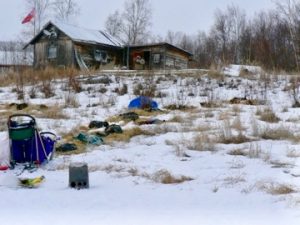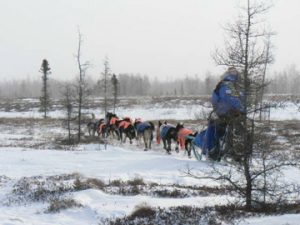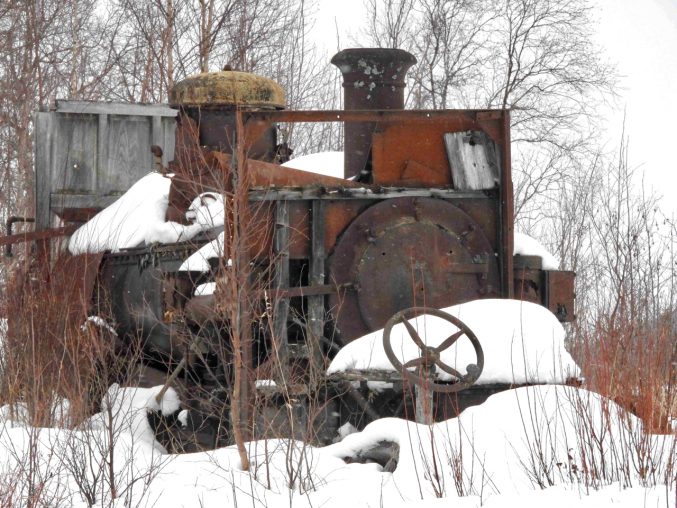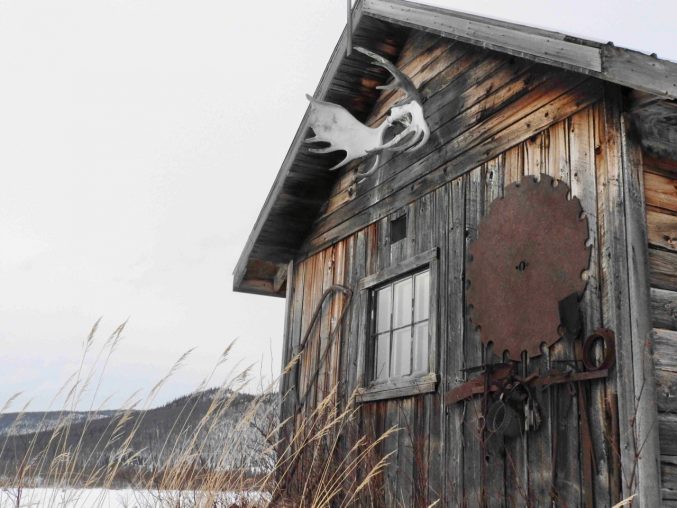- Old Building at Iditarod – photo K. Slade
- Bend of Iditarod River – photo K. Slade
- Martin Buser near Iditarod – photo K. Slade
BOO again! Sending a ghostly greeting from ghost town and checkpoint, Iditarod. Have you ever wondered where the word or name Iditarod came from? I’ve heard 3 explanations so I’ll share them with you. First, Iditarod was a word used by Athabascans that meant FAR DISTANT PLACE. Second, Iditarod was a word used in another indigenous language that meant CLEAR WATER. Finally, a ROD is a measure of distance and so one miner might ask another, “How’d you do today?” The miner would answer, “I-DID-A-ROD.” The most commonly accepted meaning is “Far Distant Place.”
Six miles out of Ophir it’s CRITICAL to know if it’s an odd or even year although the trail will be clearly marked. In odd years, teams go left at the fork in the trail, taking the “southern” route but in even years, teams fork right and travel along the “northern” route. Are you wondering why there are two routes?
Iditarod is a SIGNIFICANT event that requires a MONUMENTAL amount of work but provides ENORMOUS excitement in the everlasting winter for the people of interior Alaska. It’s a wise choice to divide the work as well as the excitement between the small interior villages along the alternate year routes.
The trail that Iditarod mushers take to Nome doesn’t exactly follow the Iditarod National Historic Trail of the early 1900s. The primary Iditarod National Historic Trail left Takotna, and dropped southwest to Flat. Then the trail headed north through Iditarod, Dikeman and Dishkakat before veering northwest to Kaltag. There were also connecting trails that went northwest out of Takotna to Ophir then Dishkakat. If a straight line were drawn from Ophir to Kaltag, Dishkakat would be about in the middle. The Iditarod Historic Trail Alliance has created several excellent resources. One is a map of the trail system during the early 1900’s and the other is a video describing the trails and how they came to be.
Have you ever considered why they don’t run the normal Iditarod race straight over to Kaltag from Ophir? Can you come up with a mileage for that “straight shot?” Why do you think they don’t go straight across today?
The eighty miles of trail between Ophir and Iditarod has many large spruce, birch and cottonwood trees. There’s not much change in elevation between Ophir and Iditarod. Mushers traverse frozen creeks, swamps and lakes as well as tundra on the way to once thriving Iditarod.
Gold was discovered on Christmas Day of 1908 near Flat, a short distance from the Iditarod River. News traveled and those seeking riches and adventure found their way either by land on the frozen Iditarod Trail or by river on steamers and then established a mining camp that became known as Iditarod on the riverbank.
- Steam Powered Tractor (Photo Credit: D. Olmstead)
- Iditarod Building (Photo Credit: D. Olmstead)
The discovery of gold near Flat launched Iditarod as a mining camp, supply station and fashionable city. During high water times, steamers could navigate to Iditarod but no farther. It therefore became the supply depot for the nearby mines of Flat and Otter Creek. By 1910, the “camp” became a well-appointed city as did Flat. The folks living in the boomtowns enjoyed the convenience of gaslights, telephones, newspapers, banks, restaurants, hotels, post office, pool hall, school and even a motorcar. Flat was only 8 miles from Iditarod. Even so a horse-drawn tramway was built connecting the booming communities. Iditarod and Flat were called the Twin Cities.
Some of the buildings in Iditarod’s sister city, Flat, have survived the test of time and nature. Buildings standing tall more than 100 years after the discovery of gold in the area include a mercantile, the school with desks and the town hall with a piano. Bush pilots who land to explore the ghost town use a runway created when miners smoothed out mounds of tailings. A video created in 2015 by Kevin Doyle and posted on YouTube gives viewers a virtual sense of Flat. There’s a gold dredge, some trucks and other mechanical relics standing around as testament to the once prosperous mines.
Except for one trapper, nobody has lived in Iditarod since 1935. Like the miners, the trapper has also moved on. Besides the trapper’s house, there is a bank vault with two-foot thick cement walls, some abandoned mining equipment and a few other shelters still standing.
More recently, a family of five lived in Flat year round to maintain the equipment for summer mining operations. When they departed in 2004, the Flat post office, zip code 99584, closed.
While reading a story in the SitNews by June Allen published in March of 2005, I learned a few things about the Twin Cities and the trail that I want to share. Allen calls the sub-Arctic trail system Alaska’s earliest expressway. What began as a trail connecting native villages evolved with time and necessity to a supply route connecting roadhouses and mining camps that sprang up during the gold rush.
The Iditarod strike turned out to be the last great hurrah of Alaska’s gold rush. The mines were depleted within a few years and the miners left but not before $33 million dollars of gold had been mined. The Iditarod post office closed in 1925. Census figures indicate 6,000 people called Flat home in 1920. But today with a population of zero for both Flat and Iditarod it’s a lonely deserted place brought to life once every two years during the activity of Iditarod.
Well, there you have it – some history and information about Iditarod and Flat, ghost towns on the Iditarod Trail. Do you suppose the mushers, dogs and volunteers can feel the “spirits” of the departed miners as they pass through Iditarod? Thanks to my friends, Kim Slade the 2007 Teacher on the Trail and Insider crew member Dorothy Olmstead for sharing pictures pictures of Iditarod. Stay tuned for more stories and remember in everything do your best everyday and have a plan.
Born to Run,
Sanka








